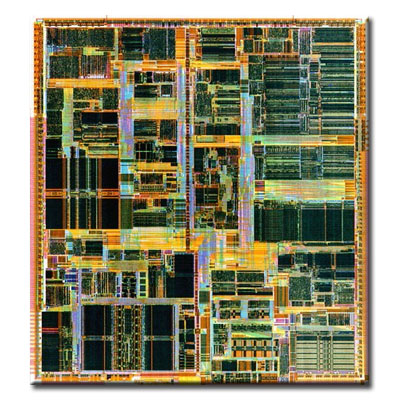Intel Pentium II (Klamath) processors
Introduction: May 1997
Overview
The Pentium II brand refered to Intel's sixth-generation microarchitecture ("Intel P6") and x86-compatible microprocessors introduced on May 7, 1997. Containing 7.5 million transistors, the Pentium II featured an improved version of the first P6-generation core of the Pentium Pro CPUs, which contained 5.5 million transistors. In early 1999, the Pentium II was superseded by the Pentium III.
In 1998, Intel stratified the Pentium II family by releasing the Pentium II-based Celeron line of processors for low-end workstations and the Pentium II Xeon line for servers and high-end workstations. The Celeron was characterized by a reduced or omitted (in some cases present but disabled) on-die full-speed L2 cache and a 66MT/s FSB. The Xeon was characterized by a range of full-speed L2 cache (from 512KB to 2048KB), a 100MT/s FSB, a different physical interface (Slot 2), and support for symmetric multiprocessing.
The Pentium II microprocessor was largely based upon the microarchitecture of its predecessor, the Pentium Pro, but with some significant improvements. Unlike previous Pentium and Pentium Pro processors, the Pentium II CPU was packaged in a slot-based module rather than a CPU socket. The processor and associated components were carried on a daughterboard similar to a typical expansion board within a plastic cartridge. A fixed or removable heatsink was carried on one side, sometimes using its own fan.
This larger package was a compromise allowing Intel to separate the secondary cache from the processor while still keeping it on a closely coupled backside bus. The L2 cache ran at half the processor's clock frequency, unlike the Pentium Pro, whose off die L2 cache ran at the same frequency as the processor. However, the smallest cache size was increased to 512KB from the 256KB on the Pentium Pro. Off-package cache solved the Pentium Pro's low yields, allowing Intel to introduce the Pentium II at a mainstream price level. This arrangement also allowed Intel to easily vary the amount of L2 cache, thus making it possible to target different market segments with cheaper or more expensive processors and accompanying performance levels.
Intel notably improved 16-bit code execution performance on Pentium II, an area in which Pentium Pro was at a notable handicap. Most consumer software of the day was still using at least some 16-bit code, because of a variety of factors. The Pentium II went to 32KB of L1 cache, double that of Pentium Pro, as well. Pentium II is also the first P6-based CPU to implement the Intel MMX integer SIMD instruction set which had already been introduced on the Pentium MMX.
Pentium II was basically a more consumer-oriented version of the Pentium Pro. It was cheaper to manufacture because of the separate, slower L2 cache memory. The improved 16-bit performance and MMX support made it a better choice for consumer-level operating systems, such as Windows 9x, and multimedia applications. Combined with the larger L1 cache and improved 16-bit performance, the slower and cheaper L2 cache's performance impact was reduced. General processor performance was increased while costs were cut.
The Klamath core
The original Klamath Pentium II microprocessor (Intel product code 80522) ran at 233 and 266MHz and were produced in a 0.35 µm process. A 300MHz version was released later in 1997. These CPUs worked with a 66MHz front side bus and initially were used on motherboards equipped with the aging Intel 440FX Natoma Pentium Pro chipset.
In Intel's "Family/Model/Stepping" scheme, Klamath CPUs were family 6, model 3.
Source: Wikipedia, the free encyclopedia.


